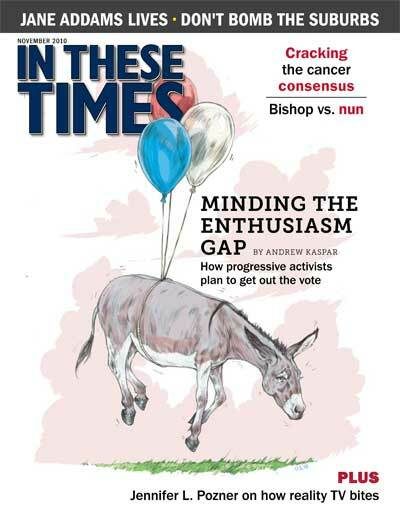Wooing the White Working Class
It’s not too late for Democrats to win back these crucial swing voters.
David Moberg

ELYRIA, OHIO – Want to know why so many Democratic candidates may find it tough to win over white working class voters this fall – and why the effort is still not a lost cause in the long run?
I found some answers one warm early fall evening as I walked up and down Hawthorne and Longfellow streets in this declining industrial city just west of Cleveland, talking about the midterm elections with the residents of the neighborhood’s modest post-World War II red brick and white clapboard bungalows.
I accompanied James Hewitt, who was wearing his bright red t-shirt with the logo on the back – “Good Jobs/A Just Economy “ – as he canvassed the neighborhood on behalf of two candidates. They were incumbent Democratic Gov. Ted Strickland, who was slipping in the polls further behind former conservative Republican Rep. John Kasich, and Rep. Betty Sutton, who normally would have had little trouble holding her seat, but this year faced a rich Republican car dealer and a dyspeptic electorate. Hewitt, 27, is assistant field director of the Cleveland office of Working America, a three-million member community affiliate of the AFL-CIO. He was calling on the organization’s members – mainly nonunion, suburban, working-class political independents or Democrats – to support these candidates.
Once a bedrock of Democratic support, white working-class voters – often defined for political polls as earning less than $50,000 or not having a college degree – have become more conservative in recent decades, moving toward Republican candidates and more conservative views. But they remain a major swing bloc of voters, especially in key battleground states like Ohio, despite the growing importance of Latino working-class voters and college-educated voters (who tend, especially those with advanced degrees, to vote slightly more Democratic than those without college degrees).
Democrats have gained among these voters since 2006 (Obama did roughly as well with working class whites as Gore or Kerry), but during the past two years have lost much support, as the working class felt the crunch of joblessness and foreclosure most acutely. Yet many blue-collar voters may still return to the Democrats this fall, and a bigger shift to the Democrats in coming years is quite plausible, depending on what the two major parties do.
“They are the voters who have pulled away most sharply [from the Democrats],” says Democracy Corps pollster Stanley Greenberg, who has long written about blue-collar voters. “The president looks inattentive to them, and his approval is lowest with white working-class voters, who are seriously alienated from the elites. But they are open to populist arguments about what’s happening, even though they are critical of Democrats as too aligned with Wall Street, not Main Street. The Democrats have not convinced white working-class voters that they are with them in this crisis.”
‘Teach the Democrats a lesson’
“Jobs,” nearly everyone said when Hewitt asked what the main political issue was for them as they considered candidates. They inevitably expressed varying degrees of disappointment with politicians’ performances in creating jobs, followed by confusion over which candidate to support, whether to vote, or what exactly they would like done. Sutton, a staunch fair-trade advocate and proponent of the “cash for clunkers” program, drew stronger support than Strickland, whom Republican opponent John Kasich has blasted with ads blaming him for the loss of 400,000 jobs during the past four years.
“I sort of want to vote all Republican to teach the Democrats a lesson,” says Virginia Kimble, a 62-year old retired nurse, who helped organize fellow hospital workers into the Service Employees International Union (SEIU). What lesson would this stalwart Democrat (who nevertheless voted for John McCain in 2008, after supporting John Edwards in the primary) like to teach? “I don’t know that it would be a lesson, but the public is tired of not having a say-so,” she says. “I just want them to listen to the people. Obama was going to do all this for the middle class. But I’m not seeing it. Even on housing – where’s the help? Could the Republicans do a better job? No. Maybe both parties should look more at how to create new jobs and not outsource so much. It’s like all our jobs are shipped to other places so companies can make more money.”
“I see everyone around me struggling” she continues, recounting how her partly deaf brother can’t afford hearing aids. “Since I was young, I thought the Democrats were for the people. Now I know you’ve got to look at the issues. But I definitely do think Democrats are less for the people now.”
Not everyone shared Kimble’s views, even if they were also disappointed. Down the street, and to her right politically, 77-year old retiree Barbara Kolodey thought Obama was “like a communist,” but didn’t vote for McCain because “he was more of a Democrat than Obama.” “The country is in sad shape,” she says. “I think the president hates the country and will do anything to destroy it.”
Maybe Kimble, like her neighbor Paula Farlow, will stay home this year. “I’m not voting for nobody,” Farlow, a medical equipment assembler says. “I usually vote, but no, I’m sorry. … Nobody’s honest. Obama has done some good, some bad, but I’m not happy with none of the parties. I’m disappointed. He just hasn’t done anything for us middle-class people. I thought he’d be more for changing regulation of overseas trade, but I don’t think he should have bailed out the banks or auto companies, even though my husband, who works for Ford, disagreed.”
Even amid the disillusionment with Democrats, others in the neighborhood found reasons – new and old – to support at least some Democrats. Walter Board, 71, a retired Ford worker, will vote Democratic this year, as always. “My grandpa told us, ” Board recalls, ” ‘If you want to walk to work and carry an empty lunch bucket, vote Republican.’ ”
But Jennifer Taylor, 45, a medical assistant out of work on disability, is wavering on her lifelong habit of voting Democratic. “With so many people laid off, maybe it’s time for a change,” she says. “Obama didn’t do enough.” Much as she admired Obama for promoting healthcare reform, for example, she wanted a more European or Canadian plan. Nor did Strickland do enough, but Hewitt’s reminder that Kasich worked on Wall Street (for Lehman Brothers) provoked a smile of sudden awareness, prompting Taylor to say, “I’m not crazy about that.” After Hewitt urged her to give Strickland more time, she switched from opposing him to undecided.
Out of work since last Christmas, union sheet metal worker Rob Scheithauer, 30, says, “I’m just waiting for change, like [Obama] promised.” But he acknowledges that “things aren’t going to change overnight, so I’ll give him the benefit of the doubt.” Not so with Strickland, who “needs to go.” Another member of the crucial wave of young voters for Obama, 25-year-old Matthew Butler, is mixing pro-management ideas from his college business training with his family’s working-class Democratic loyalties and his own liberal views on individual rights. But his favorable, if mixed, views of Obama’s performance don’t influence his views on other races, as he weighs his often conflicting values and remains undecided.
The problem with white men
The muddled opinions along Hawthorne and Longfellow streets underscore the lack of enthusiasm among Democratic voters, partly resulting from the Obama administration’s inability to produce immediate, tangible gains for working-class families. But these wavering blue-collar Democrats and independents also want to feel as if the politicians in power understand them and their concern, for example, about the effects of globalization.
“With working-class, non-union whites, the bottom has fallen out,” says AFL-CIO assistant political director Michael Podhorzer. “That’s a big factor in the change of fortunes of the Democrats. From 2006 to 2008 Democrats had rebounded with white working-class voters, but since the election, they’re the largest group that’s dropped very sharply. I think it’s the bad economy and the sense that the rich have weathered the economic crisis well, and that they haven’t. Among union members, the Republican message has not garnered traction, but there is demoralization and lack of recognition of how serious the Republican threat is. … There’s a lack of enthusiasm about everything.” But Podhorzer says the labor union messages at work and at home have begun to energize members.
The Democrats’ problem is mainly with white working-class, nonunion men. For example, in a Greenberg survey for the Campaign for America’s Future, white working-class men supported a Republican over Obama for the 2012 elections more than college-educated men, while women, regardless of education, favored Obama. Also, pollster Celinda Lake found in battleground states that 48 percent of blue-collar women approved Obama’s economic policies, but only 38 percent of men. By substantial margins, blue-collar men thought Republicans could better handle the economy and create jobs; by similar margins, blue-collar women trusted Democrats. “This gender gap reflects different perceptions of the role of government,” Lake says. “Women believe government could be part of the solution, but men believe government is part of the problem.”
Of course, working-class men in unions believe in and vote much more in favor of a strong government role than nonunion men. And voters like Jennifer Taylor, reached by groups like Working America or their unions, hear a different interpretation of the world, and most are open to it. “People basically are hurting and confused, not with a particularly partisan take,” Working America director Karen Nussbaum says. “Things are open. They’re not shut down.”
The millennial generation (age 18 to 32) is particularly open to progressive Democratic proposals, since they – both college-educated and non-college educated – show much more trust in government and more support (by 63 to 46 percent) for a significant government role in solving problems than older Americans do, as Guy Molyneux and Ruy Teixeira reported to the Center for American Progress Action Fund. Unfortunately for Democrats, this key group appears disengaged from the 2010 elections, despite largely continuing to support Obama.
A ‘rising American electorate?’
American workers feel justifiably disillusioned with the Democratic Party, which has grown more beholden to financial and corporate elites. (Some white working-class alienation, however, has tragically reflected alienation from Democrats’ past advancement of civil rights.) Yet white working-class Americans still hold at least residual notions that the Democrats are the party of working people and Republicans are the party of the rich. With unions or other groups organizing and educating voters, that view grows stronger.
Even as Democratic prospects for the fall elections looked grim, with generic congressional polls showing Republicans up by as much as seven points, Greenberg in September tested messages that suggested Democrats could still turn around as much as 9 percent of all voters. (See “Minding the Enthusiasm Gap,” page 18.) The winning messages emphasized changing Washington and supporting the middle class against Wall Street (although white blue-collar voters responded more strongly to a combination of supporting the middle class against Wall Street with defense of Social Security and Medicare). By contrast, the dominant White House/Democratic theme of moving forward, not going back, actually lost a few voters.
In the long run, the prospects are promising for a more progressive white working class, since young people, both working- and middle-class, hold more pro-government views. They will be joined by what Greenberg calls the “rising American electorate” (single women and people of color, in addition to youth), who share high expectations for government.
Of course, none of these nascent trends will matter if Democrats fail to be the agent of working- and middle-class hopes. This fall, the pressing issue for Democrats is not long-term demographics but how to mobilize the disillusioned progressive potential that still exists, despite the deep swing against their party, on Hawthorne and Longfellow Streets all over the country.
David Moberg, a former senior editor of In These Times, was on staff with the magazine from when it began publishing in 1976 until his passing in July 2022. Before joining In These Times, he completed his work for a Ph.D. in anthropology at the University of Chicago and worked for Newsweek. He received fellowships from the John D. and Catherine T. MacArthur Foundation and the Nation Institute for research on the new global economy.









